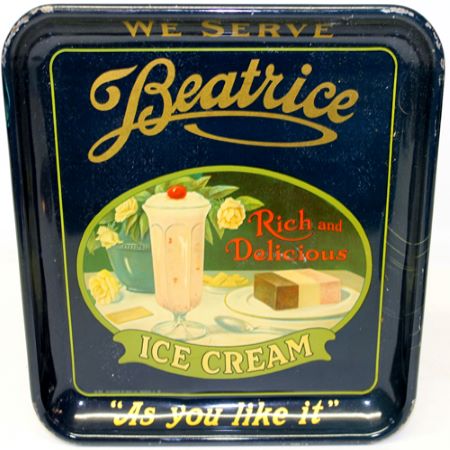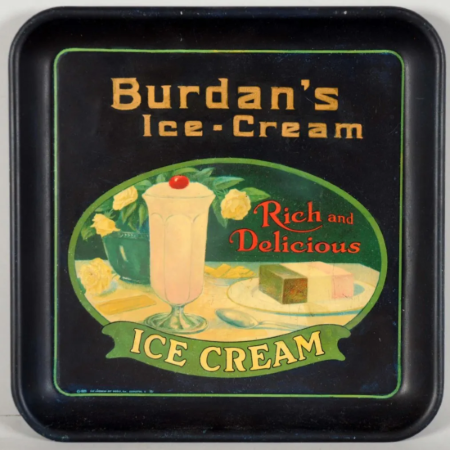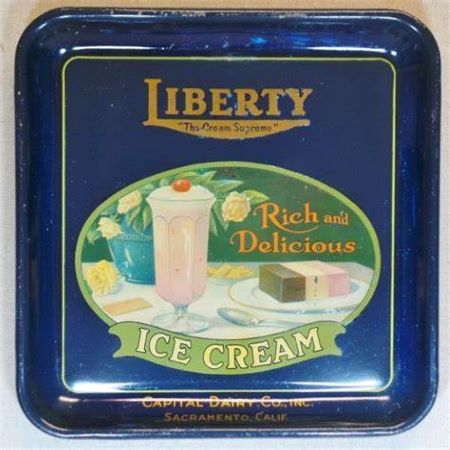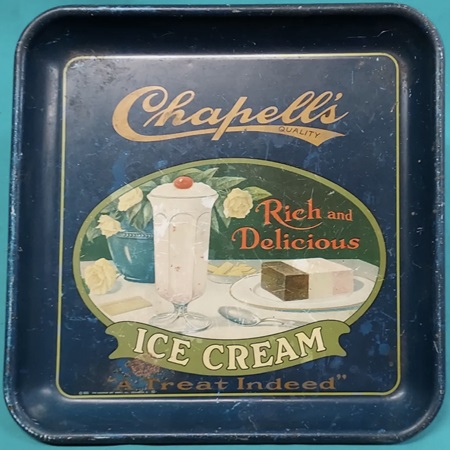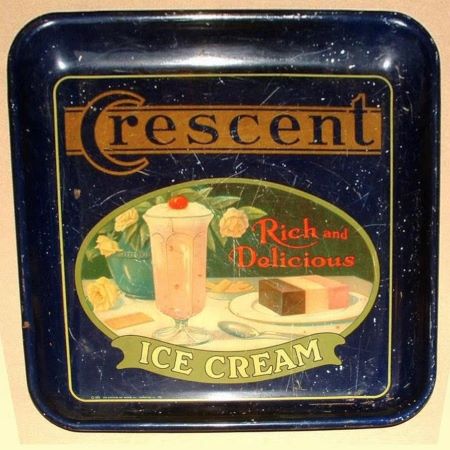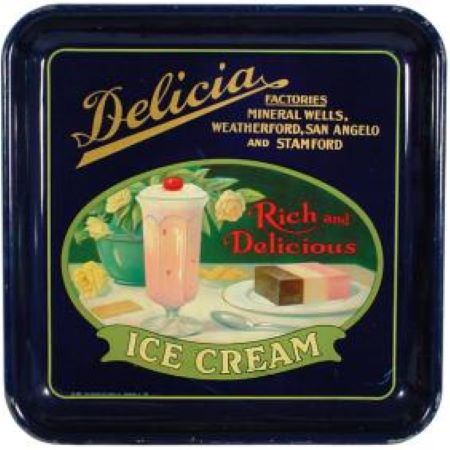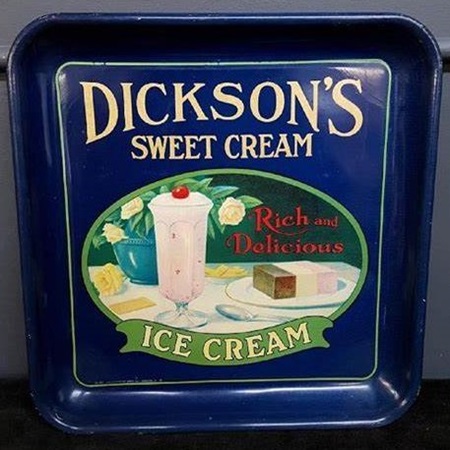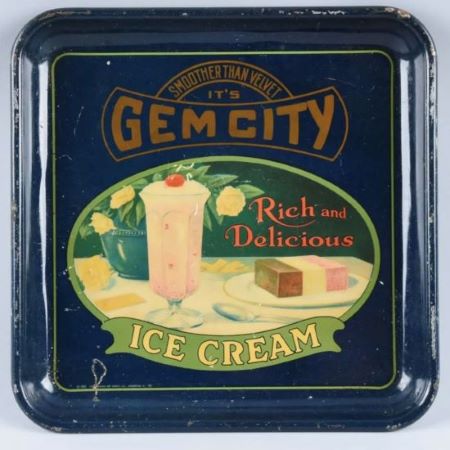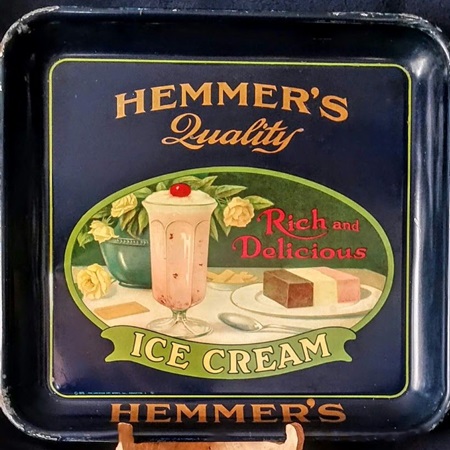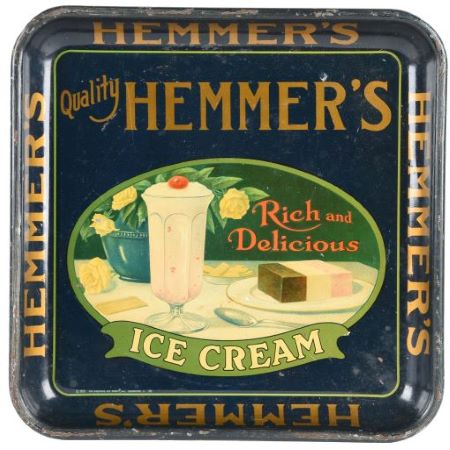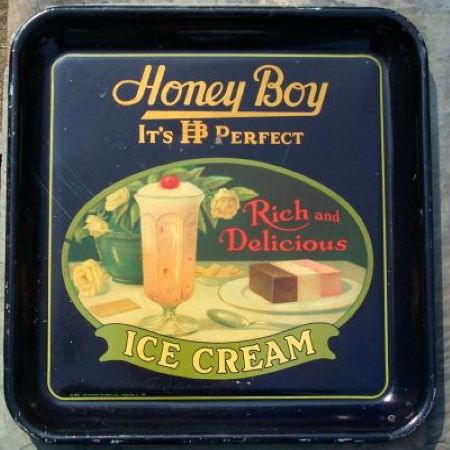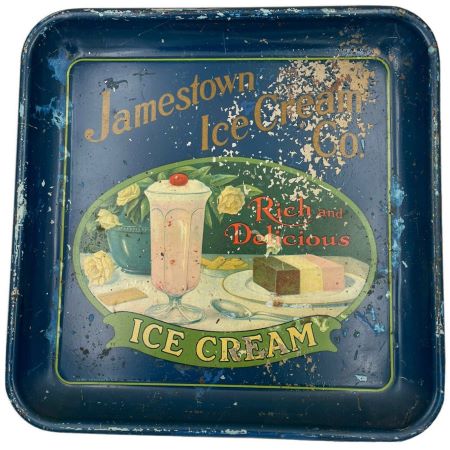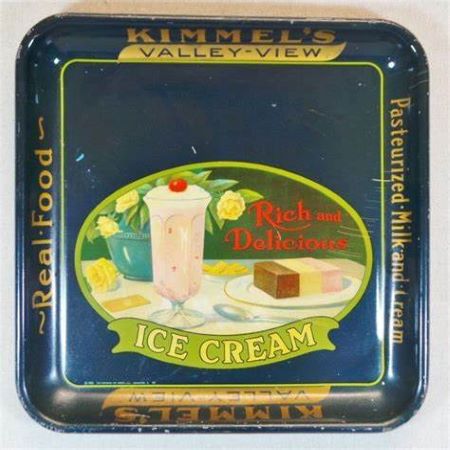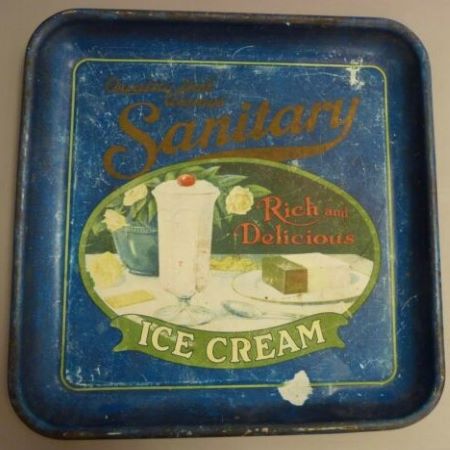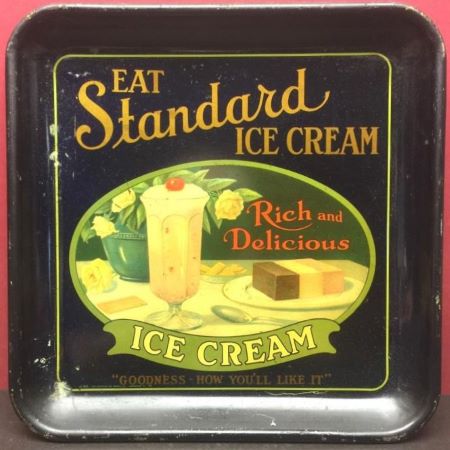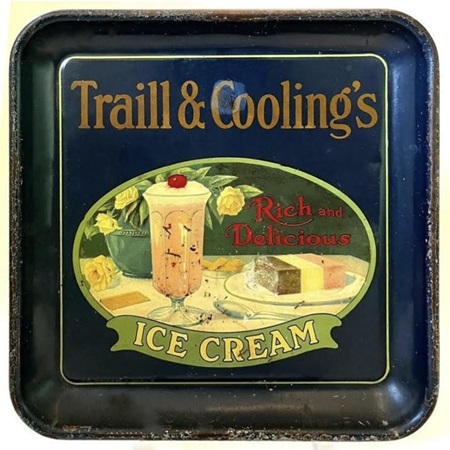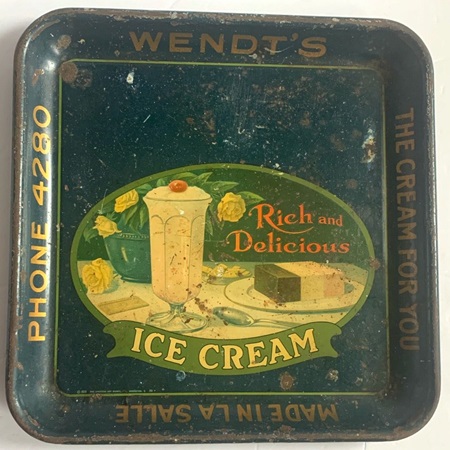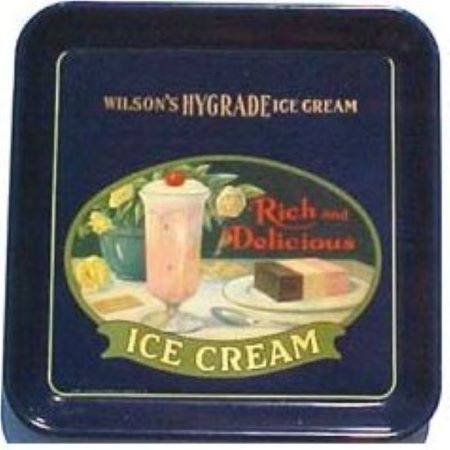The 'Stock' Exchange
American Art Works: No. 151 "Rich & Delicious"
American Art Works: No. 151 "Rich & Delicious"
Date: 1925 - 1930
Size: 13.5" x 13.5"
Type: Pie
Scarcity: Common
Value: $$ to $$$
Condition & Brewer Dependent
Size: 13.5" x 13.5"
Type: Pie
Scarcity: Common
Value: $$ to $$$
Condition & Brewer Dependent


General Comments
Another two years passed between the release of No. 150 “When Dreams Come True” and this design, again clearly aimed at the ice cream market, as are all of the remaining American Art Works stock designs that are known, save one (No. 154). This is also the last design to include the copyright date (1925). There is something quite different about the lithograph here, it almost looks like a decal that was applied to the tray and has a very flat aspect to it. Also, the colors are fairly pastel compared with the typical palate of other designs. They must have had good success given the number of companies that used this design.
We believe this may have been American Art Works attempt to produce a less expensive design to compete more effectively against low priced competitors. To our knowledge, among their traditional competitors, only Kaufmann & Strauss offered ice cream specific stock designs, but they appear to have ceased operations. However, some new competitors had entered the field, specifically targeting the ice cream market with their stock designs. Foremost among these were The Tin Decorating Company of Baltimore, MD and Parker-Brawner Company of Washington, DC.
The Tin Decorating Company (Tindeco) of Baltimore was incorporated in 1914, taking over the tin department of the American Tobacco Company and by 1922 reportedly was the largest tin decorating plant in the world with over 7 acres of operating floor space. Tindeco’s initial focus was on “tin containers.”
Another two years passed between the release of No. 150 “When Dreams Come True” and this design, again clearly aimed at the ice cream market, as are all of the remaining American Art Works stock designs that are known, save one (No. 154). This is also the last design to include the copyright date (1925). There is something quite different about the lithograph here, it almost looks like a decal that was applied to the tray and has a very flat aspect to it. Also, the colors are fairly pastel compared with the typical palate of other designs. They must have had good success given the number of companies that used this design.
We believe this may have been American Art Works attempt to produce a less expensive design to compete more effectively against low priced competitors. To our knowledge, among their traditional competitors, only Kaufmann & Strauss offered ice cream specific stock designs, but they appear to have ceased operations. However, some new competitors had entered the field, specifically targeting the ice cream market with their stock designs. Foremost among these were The Tin Decorating Company of Baltimore, MD and Parker-Brawner Company of Washington, DC.
The Tin Decorating Company (Tindeco) of Baltimore was incorporated in 1914, taking over the tin department of the American Tobacco Company and by 1922 reportedly was the largest tin decorating plant in the world with over 7 acres of operating floor space. Tindeco’s initial focus was on “tin containers.”
Confirmed Brewer used Stock Trays
Non-Beer Related & Non-Tray Uses

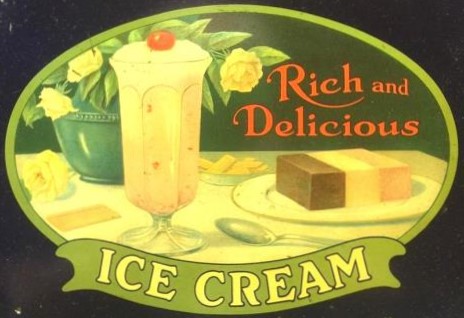
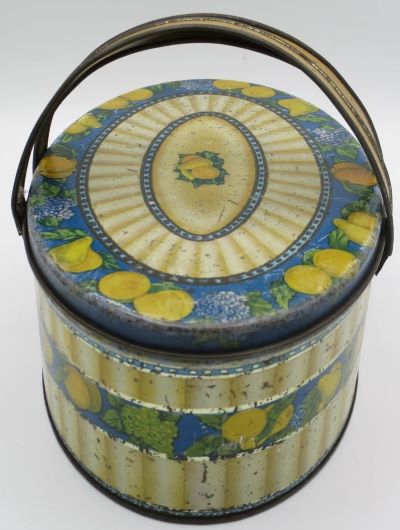
The Tin Decorating Company (Tindeco) of Baltimore was incorporated in 1914, taking over the tin department of the American Tobacco Company and by 1922 reportedly was the largest tin decorating plant in the world with over 7 acres of operating floor space. Tindeco’s initial focus was on “tin containers” and they apparently were using newer photolithographic equipment, which seems to have produced a much thinner application of paint (which generally speaking, did not hold up as well over time). It typically employed 1500 people, but at maximum capacity could accommodate up to 2800.
An article in The Annual Report of the Merchant and Manufacturers’ Association of Baltimore, MD from May 1922 indicates that until 1921, Tindeco “was confined exclusively to the manufacture of special design boxes.” But in response to the general depression, “officials of the Company were confronted with the problem of seeking additional markets in a new field in order to keep the wheels turning of their huge plant.” The first new product was “a stock line of boxes” and further innovations ended up including napkin rings, wastebaskets, trays, plate (see child's plate to the left) plaques, crumber sets, and other “useful” articles.
An article in The Annual Report of the Merchant and Manufacturers’ Association of Baltimore, MD from May 1922 indicates that until 1921, Tindeco “was confined exclusively to the manufacture of special design boxes.” But in response to the general depression, “officials of the Company were confronted with the problem of seeking additional markets in a new field in order to keep the wheels turning of their huge plant.” The first new product was “a stock line of boxes” and further innovations ended up including napkin rings, wastebaskets, trays, plate (see child's plate to the left) plaques, crumber sets, and other “useful” articles.
Ice Cream Tin Container
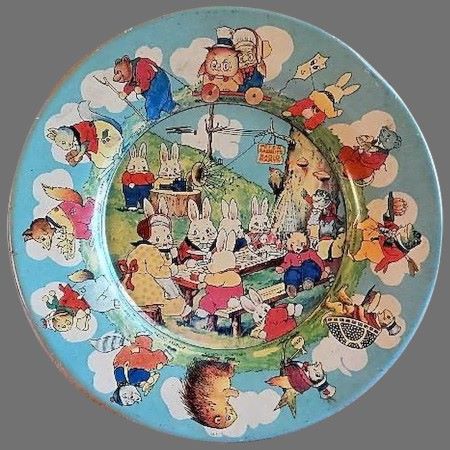
Childs Ice Cream Plate
Another competitor about whom less is known is Parker-Brawner, incorporated in in 1907 apparently as a printing concern that produced postcards and posters. A March 1923 issue of The Ice Cream Journal carries an article by W R Jennings of Parker-Brawner Co., Washington, DC entitled “Building Ice Cream Gallonage at Present Stops” clearly indicating that Parker-Brawner was focused on this market by 1923 if not earlier. Later, in the May issue he is listed as a speaker at the Seventeenth Annual Convention of the Association of Ice Cream Manufacturers of Pennsylvania and New Jersey, and spoke on advertising and sales methods in a speech entitled “Increasing Gallonage at Old and Friendly Stops.” A 1929 article in Dairy Products Merchandising refers to “ice cream advertising materials” produced by Parker-Brawner.
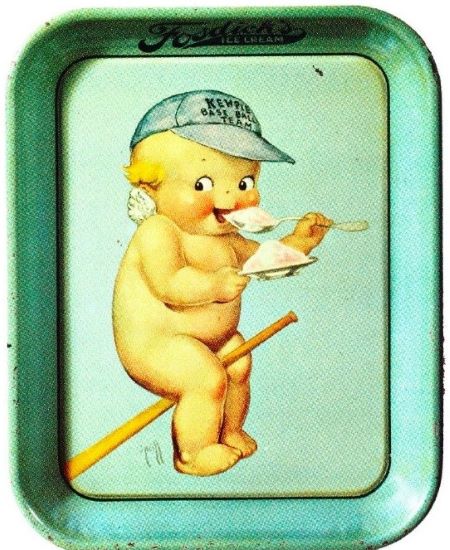
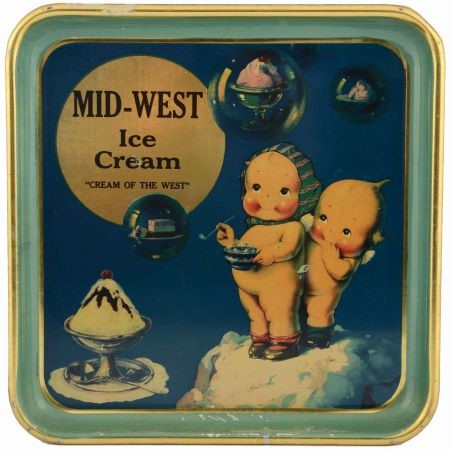
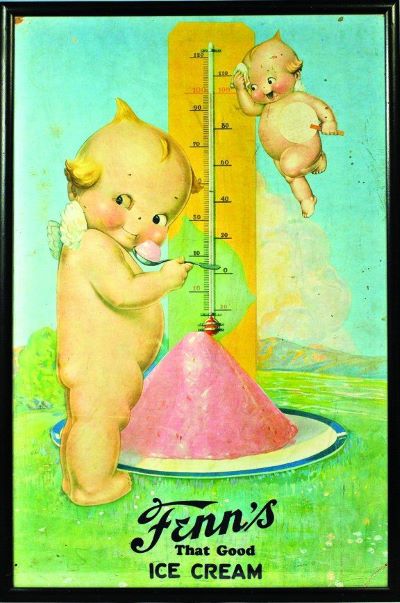
Parker-Brawner is probably best known for their trays featuring kewpie figures including some ice cream designs. The Kewpie was a brand of dolls and figurines that were conceived as comic strip characters by cartoonist Rose O'Neill. The comic, featuring the cherub-faced characters, was first printed in Ladies' Home Journal in the December 1909 issue. O'Neill described the characters as "a sort of little round fairy whose one idea is to teach people to be merry and kind at the same time.” The name Kewpies is derived from Cupid, the Roman god of erotic love. The characters were first produced as bisque dolls in Waltershausen, Germany, beginning in 1912, and became extremely popular in various types of advertising in the early 20th century, as evidenced by this ice cream-oriented print ad.
Sahling's Design Notes
By this time Sahling had left the Art Department and there are no more entries in his workbook.
Size, Shape and Message Placement
All examples we have seen have been 14x14 squares. Like the later woodgrain designs of “A Helping Hand” (No. 139) and “Heine” (No. 142) the rim is a continuation of the face of tray, separated by a thin line near the transition from face to rim. Unlike most designs, the majority of examples carry the advertising text (in gold) on the face of the tray given that were was a large blank area above the ice cream image. A few examples also have gold advertising text on the rim.
Hager & Price
Hager does not have any designs beyond “When Dreams Come True”; perhaps like us (initially), he did not recognize this as a stock design or even an American Art Works design, given how different it is from all of the others. Most examples below average condition go for lower double figures; average to slight above average go for mid to upper double figures; and better examples can reach into the lower triple figures.
Sahling's Design Notes
By this time Sahling had left the Art Department and there are no more entries in his workbook.
Size, Shape and Message Placement
All examples we have seen have been 14x14 squares. Like the later woodgrain designs of “A Helping Hand” (No. 139) and “Heine” (No. 142) the rim is a continuation of the face of tray, separated by a thin line near the transition from face to rim. Unlike most designs, the majority of examples carry the advertising text (in gold) on the face of the tray given that were was a large blank area above the ice cream image. A few examples also have gold advertising text on the rim.
Hager & Price
Hager does not have any designs beyond “When Dreams Come True”; perhaps like us (initially), he did not recognize this as a stock design or even an American Art Works design, given how different it is from all of the others. Most examples below average condition go for lower double figures; average to slight above average go for mid to upper double figures; and better examples can reach into the lower triple figures.
Click the Picture to Return to Meek & Beach Stock Catalog Page
